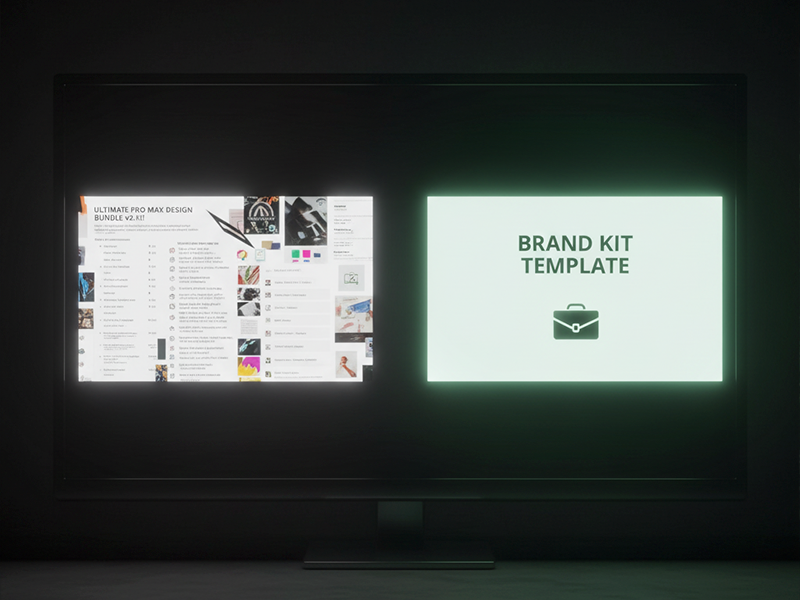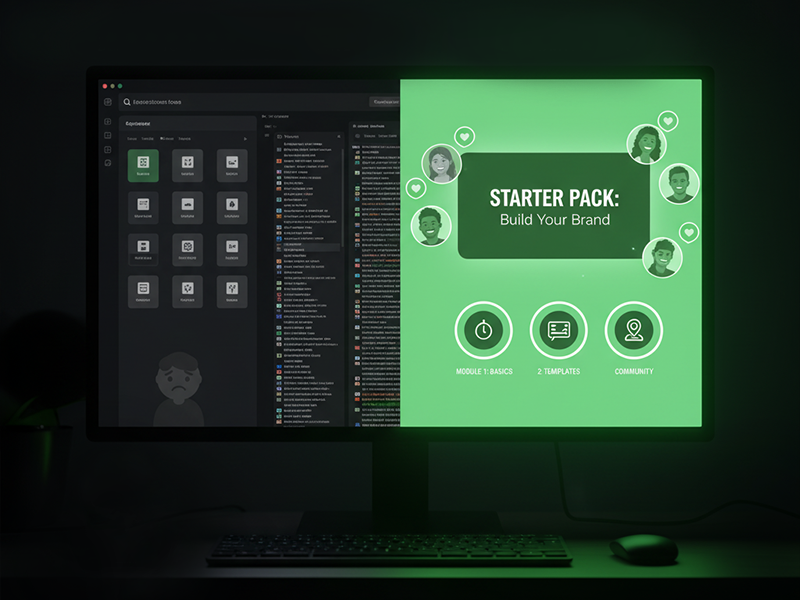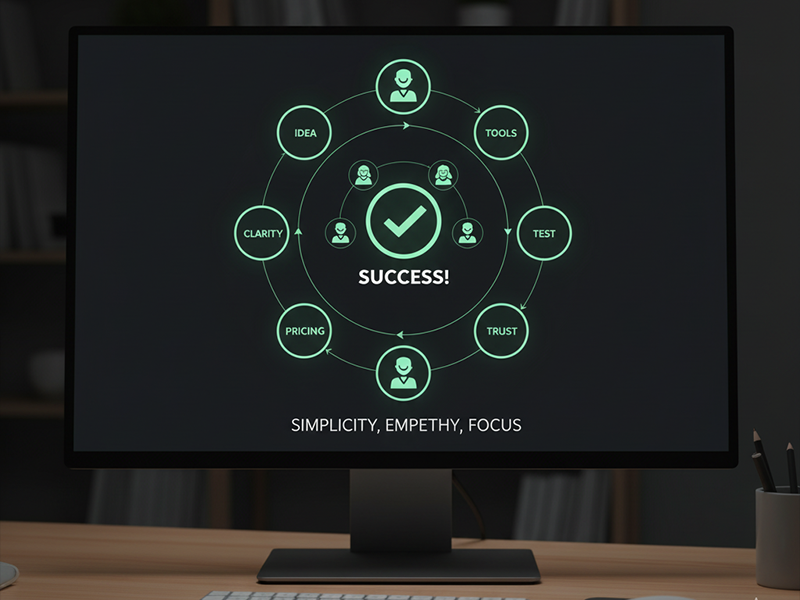6 Steps To Create A Digital Product That People Actually Buy
How to turn your ideas into products that sell without feeling overwhelmed or getting lost in the tech
- October 24, 2025
- Indra
- 8:39 am

The dream that often turns into frustration
You finally decide to create a digital product. Maybe it is an online course, a set of templates, or an ebook. You pour your time into it, design every detail, and imagine the moment someone clicks buy. But when you launch, the silence is louder than expected. A few likes, a few comments, but barely any sales.
You are not alone. Many creators, coaches, and freelancers face the same disappointment. The problem is rarely the product itself. It is that most digital products are built from the creator’s perspective instead of the buyer’s reality.
When you flip that mindset and build for the person who will buy rather than the one who is creating, you start to make something that sells naturally.
This article breaks down six clear, human steps to create a digital product that people not only want but trust enough to pay for.
What we will cover
- How to spot an idea people already want
- Why clarity beats creativity in product design
- Building value with simple tools you already know
- How to test your idea before you create everything
- Pricing your product so it feels right for buyers and fair for you
- Turning interest into repeat sales through trust and connection

Step one identify an idea people already want
Great products do not start with creativity. They start with curiosity. The best creators listen before they build.
Spend a few days observing the questions people ask in your niche. Check Instagram comments, Reddit threads, or community spaces. Notice what problems come up repeatedly. Those recurring frustrations are your starting point.
How to validate your idea
Ask five to ten people in your target audience what they have tried and why it did not work. You can do this through Calendly calls or short surveys on Google Forms. Look for emotional words such as frustrated, confused, tired, or stuck. Those emotions reveal what people will pay to solve.
A productivity coach once thought her audience wanted a course on goal setting. After a few interviews, she realized they did not want more goals. They wanted a way to stay consistent. She shifted her product to a daily Notion tracker for habit building and sold one hundred copies in the first month.
When you listen closely, you do not have to convince people to buy. They already feel seen.

Step two clarity beats creativity in product design
Many creators fall into the trap of overbuilding. They add features, bonuses, and visuals hoping it will impress buyers. But the truth is that clarity sells more than complexity.
Buyers rarely ask what else is included. They ask whether it will actually help them.
Focus on transformation
Every product must lead to one clear outcome. A course that helps people finish their first ebook. A template that organizes their finances. A system that saves them time every week. The clearer the promise, the easier the purchase.
Use plain language. Replace clever titles with phrases that describe the result. “Plan your week in ten minutes” converts better than “The Time Architect System.”
A designer on Gumroad once renamed her product from “The Visual Strategy Vault” to “Brand Kit Template for Canva.” Within a week, her conversion rate doubled. People finally understood what they were getting.
Simplicity builds trust. When buyers understand your product instantly, they stop scrolling and start buying.

Step three build value with tools you already know
Creating a digital product does not require expensive software or complicated platforms. In most cases, the best tools are the ones you already use every day.
You can design templates in Canva, organize materials in Notion, collect payments through Stripe or Gumroad, and deliver content using Google Drive or Dropbox.
Keep it lean
Start with the minimum version that delivers results. For example, if you are creating an online course, begin with recorded Zoom sessions or short videos uploaded to a private Google Drive folder. Once sales prove demand, you can reinvest into a course platform later.
A nutrition coach built her first meal planning guide entirely in Google Docs, collected payments via Stripe links, and used Calendly for optional coaching calls. She made over six thousand dollars in her first two months without a single software upgrade.
When you remove technical pressure, your creativity has room to focus on value.

Step four test your idea before you build everything
The biggest mistake most creators make is spending months perfecting a product no one has confirmed they want. Testing early prevents wasted effort and builds anticipation at the same time.
How to pre sell your product
- Create a one page description of what your product does and who it helps
- Share it with your audience through email, social posts, or a short video
- Offer early access at a discounted rate for a limited number of buyers
If people pay before the product exists, that is the strongest validation you can get. It proves your concept and funds its creation.
A copywriter pre sold her “Launch Email Toolkit” to her Instagram audience using a single post. She set a goal of twenty early buyers at twenty five dollars each. She sold out within two days, then used that feedback to refine the templates before her full launch at fifty dollars.
This approach not only saved her time but also created loyal early supporters who became repeat buyers.
Testing your idea early transforms uncertainty into confidence and turns your audience into collaborators.

Step five price your product so it feels right for buyers and fair for you
Pricing often triggers anxiety. Charge too little and your work feels undervalued. Charge too much and people hesitate. The goal is not the lowest price. It is the clearest value.
How to find your sweet spot
List what your product helps people achieve. Then estimate what that result is worth in time, energy, or money saved. If your template saves someone five hours a week and their time is worth fifty dollars an hour, the value is two hundred fifty dollars. Pricing it at seventy nine dollars suddenly feels like a bargain.
Remember, people do not buy files. They buy outcomes.
A course creator once sold a “Content Calendar System” for fifteen dollars. After calculating the time it saved marketers, she raised the price to ninety nine dollars and added a thirty minute setup video. Her sales tripled, and buyers described it as finally worth paying for.
When your pricing matches the value you deliver, you do not have to justify the cost. The result speaks for itself.

Step six turn interest into repeat sales through trust and connection
A successful product launch is exciting, but the real growth comes from what happens after the first sale. People who already bought from you are far more likely to buy again if they trust your process.
Keep communication personal
Send thank you emails, ask for feedback, and share quick wins from other customers. Use tools like Notion to track buyer insights and Calendly to schedule follow up calls or live Q&A sessions. This not only builds trust but also gives you ideas for your next product.
A graphic designer noticed her best customers kept asking how she organized her design files. She turned that question into a second product called “The Freelancer File System” and sold it directly to her existing buyers. Eighty percent of her revenue came from people who had already purchased once.
Trust compounds. When buyers feel supported and understood, they become advocates who sell your work for you.

A real before and after transformation
Before a travel blogger created an elaborate online course on content strategy. It had ten modules, worksheets, and fancy graphics, but barely anyone bought it.
After she simplified her offer to a short “Travel Writing Starter Pack,” built with Notion templates and two video lessons. She priced it at forty nine dollars and promoted it to her existing email list. Within two weeks, she made over three thousand dollars and received glowing feedback about how simple and clear it was.
Her success was not about lowering her standards. It was about removing confusion so buyers could say yes without hesitation.
When clarity replaces complexity, results come faster.

Bringing it all together
Creating a digital product that sells is not about being the most creative person in your niche. It is about being the most empathetic. Every step from idea validation to pricing comes down to understanding what your audience values most and making it effortless for them to get it.
Here is a quick recap to keep you focused
- Listen before you build
- Promise one clear outcome
- Use tools you already know
- Test your idea before you create it fully
- Price based on results, not features
- Build relationships with buyers after the sale
When you build products this way, you do not chase trends or algorithms. You build assets that continue to sell because they genuinely solve problems people care about.
Making digital creation simpler
The process of creating and selling digital products does not need to feel overwhelming. With the right systems, you can focus on creativity while technology runs quietly in the background.
If you are ready to bring structure and calm to your creative process, explore Briefee. It helps small business owners and creators organize their ideas, plan launches, and manage workflows without getting lost in endless tools.
Your best product is not the one that looks the fanciest. It is the one that helps someone feel a little more capable the moment they use it. Build that, and people will not just buy. They will come back for more.
2025 © Briefee. All Rights Reserved.
